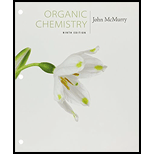
a)

Interpretation:
Whether the electrocyclic reaction shown takes place in conrotatory or disrotatory manner is to be stated. The conditions, thermal or photochemical, under which the reaction can be carried out also is to be stated.
Concept introduction:
In elecrocyclic reactions involving even number of electron pairs, a thermal reaction occurs in conrotatory manner and a photochemical reaction occurs in disrotatory manner.
In elecrocyclic reactions involving odd number of electron pairs, a thermal reaction occurs in disrotatory manner and a photochemical reaction occurs in conrotatory manner.
b)

Interpretation:
Whether the electrocyclic reaction shown takes place in conrotatory or disrotatory manner is to be stated. The conditions, thermal or photochemical, under which the reaction can be carried out also is to be stated.
Concept introduction:
In elecrocyclic reactions involving even number of electron pairs, a thermal reaction occurs in conrotatory manner and a photochemical reaction occurs in disrotatory manner.
In elecrocyclic reactions involving odd number of electron pairs, a thermal reaction occurs in disrotatory manner and a photochemical reaction occurs in conrotatory manner.
Trending nowThis is a popular solution!

Chapter 30 Solutions
Student Value Bundle: Organic Chemistry, + OWLv2 with Student Solutions Manual eBook, 4 terms (24 months) Printed Access Card (NEW!!)
- Please help me solve this reaction.arrow_forwardIndicate the products obtained by mixing 2,2-dimethylpropanal with acetaldehyde and sodium ethoxide in ethanol.arrow_forwardSynthesize 2-Ethyl-3-methyloxirane from dimethyl(propyl)sulfonium iodide using the necessary organic or inorganic reagents. Draw the structures of the compounds.arrow_forward
- Synthesize 2-Hydroxy-2-phenylacetonitrile from phenylmethanol using the necessary organic or inorganic reagents. Draw the structures of the compounds.arrow_forwardSynthesize N-Methylcyclohexylamine from cyclohexanol using the necessary organic or inorganic reagents. Draw the structures of the compounds.arrow_forwardSynthesize N-Methylcyclohexylamine from cyclohexanol using the necessary organic or inorganic reagents. Draw the structures of the compounds.arrow_forward
- If possible, please provide the formula of the compound 3,3-dimethylbut-2-enal.arrow_forwardSynthesize 1,4-dibromobenzene from acetanilide (N-phenylacetamide) using the necessary organic or inorganic reagents. Draw the structures of the compounds.arrow_forwardIndicate the products obtained by mixing (3-oxo-3-phenylpropyl)triphenylphosphonium bromide with sodium hydride.arrow_forward
- We mix N-ethyl-2-hexanamine with excess methyl iodide and followed by heating with aqueous Ag2O. Indicate the major products obtained.arrow_forwardIndicate the products obtained by mixing acetophenone with iodine and NaOH.arrow_forwardIndicate the products obtained by mixing 2-Propanone and ethyllithium and performing a subsequent acid hydrolysis.arrow_forward
 Organic Chemistry: A Guided InquiryChemistryISBN:9780618974122Author:Andrei StraumanisPublisher:Cengage Learning
Organic Chemistry: A Guided InquiryChemistryISBN:9780618974122Author:Andrei StraumanisPublisher:Cengage Learning Organic ChemistryChemistryISBN:9781305580350Author:William H. Brown, Brent L. Iverson, Eric Anslyn, Christopher S. FootePublisher:Cengage Learning
Organic ChemistryChemistryISBN:9781305580350Author:William H. Brown, Brent L. Iverson, Eric Anslyn, Christopher S. FootePublisher:Cengage Learning




